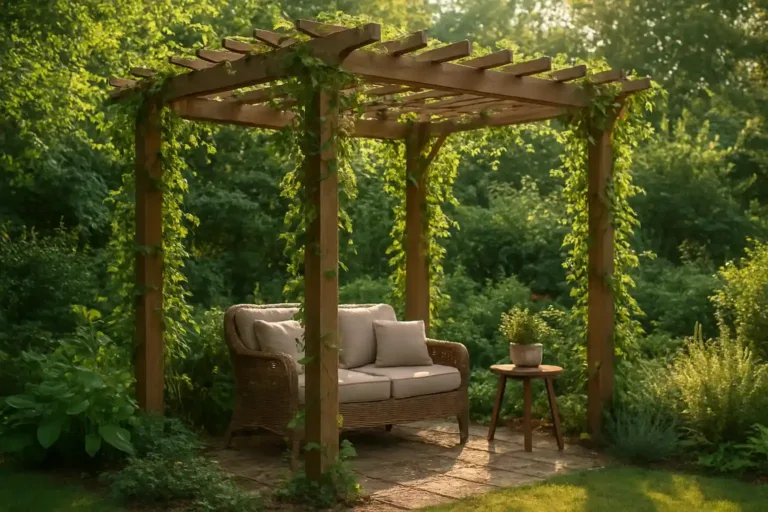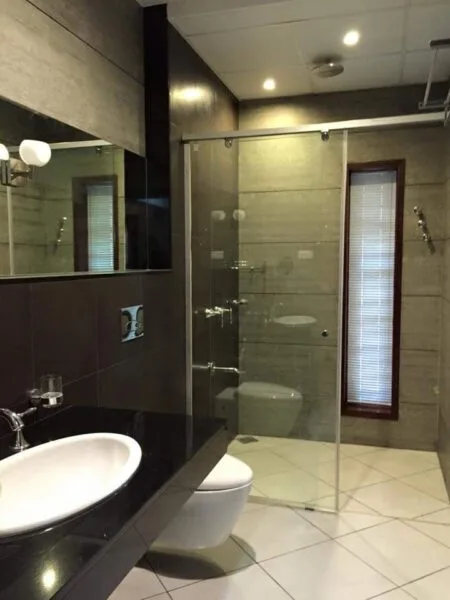
What is a Pergola?
A pergola is an outdoor structure made up of vertical pillars or columns that support a roof of crossbeams and open lattice, forming a shaded promenade, passageway, or seating area. Unlike a fully enclosed gazebo, a pergola gives some shade while still allowing sunshine and air to pass through, making it excellent for gardens, patios, and terraces.
Pergolas are frequently used to support climbing plants or vines, which adds natural beauty and improves the outdoor atmosphere. They can be built of a variety of materials, such as wood, aluminum, steel, or vinyl, and are available in both traditional and modern styles to match any outdoor setting.
Pergolas are popular in both residential and commercial settings because they enhance the aesthetic appeal and value of houses, gardens, and entertainment areas, in addition to defining a useful outdoor space.
Where Did Pergolas Originate?
Pergolas have a long history, dating back to ancient civilizations when they were utilized to create shaded walkways and garden buildings. The idea is thought to have started in Egypt, where buildings covered in vines offered shade from the sun. Pergolas gained popularity in gardens and houses during the Renaissance as the concept expanded throughout Europe, especially Italy and the Mediterranean region.
Pergolas, which are traditionally composed of wood or stone, were designed to support climbing plants while also creating lovely outdoor places for leisure and social gatherings. While materials and designs have developed throughout time, the goal remains the same: to blend beauty, shade, and practicality in outdoor living spaces.
What is the Purpose of a Pergola?
The pergola is used for creating attractive and useful outdoor spaces that offer partial shade while enabling sunlight and airflow. It improves the visual attractiveness and practicality of gardens, patios, and terraces by providing a designated space for lounging, dining, or entertaining.
Pergolas also support climbing plants and vines, bringing a natural, green accent to outdoor settings. Beyond their aesthetic value, they are a useful element for both residential and commercial landscapes since they may direct walkways, frame views, and offer architectural character.
A pergola, in essence, combines usefulness, shade, and elegance to transform ordinary outdoor areas into appealing, delightful environments.
Does a Pergola Add Value to a Home?
Yes, a pergola may greatly increase a home’s charm and value. A pergola gives homeowners a welcoming outdoor living area that is ideal for entertaining and lounging. Its visual appeal, mixed with usefulness, improves curb appeal and makes gardens, patios, and terraces more appealing to prospective purchasers.
Furthermore, a well-designed pergola can support landscape features like climbing plants, blend in with a home’s architecture, and provide a chic focal point in the backyard. While it may not boost a home’s square footage, a pergola improves perceived value, making the property more appealing and relaxing.
How Much Does a Pergola Cost to Build?
Pergola in Thodupuzha construction costs can vary significantly based on labor, size, design, and materials. The intricacy of the installation, site preparation, and finishing touches like paint, stain, or climbing plants are additional variables that affect cost. While the initial cost may vary, a pergola not only improves outside aesthetics but also increases the utilitarian appeal and perceived value of a property, making it a desirable addition.
Are Pergolas Sustainable
Pergolas can be a sustainable addition to outdoor areas, depending on the building materials and techniques employed. Reclaimed wood, timber from sustainable sources, or recycled metals are less harmful to the environment than traditional building materials when used to construct pergolas.
Additionally, pergolas can accommodate climbing plants and greenery, which not only improve visual appeal but also help with natural cooling and air purification in outdoor areas. Lightweight and robust materials, such as aluminum or steel, require less frequent replacement, further lowering environmental impact.
Pergola Components
- Posts or Columns: The vertical supports that give the pergola stability and support. Vinyl, metal, or wood can be used to make these.
- Beams: Horizontal supports extend over the tops of the posts, forming the roof’s main skeleton.
- Rafters: Rafters are placed on top of the beams to form an open, slatted ceiling that gives partial shade and framework for climbing plants.
- Lattice or Crossbeams: Optional features that improve the roof’s appearance, provide additional support, and let vegetation grow alongside them.
- Footings or Base Anchors: Securing the posts to the ground ensures stability and durability. These could be metal brackets, concrete, or other anchoring devices.
- Decorative Elements: Optional features such as trim, moldings, or pergola caps that improve aesthetics and enhance the overall design.
How to Paint a Pergola
Choose the Right Paint: Use exterior-grade paint or stain that is resistant to moisture and UV radiation for wooden pergolas. For metal pergolas, use rust-resistant paint designed for aluminum or steel surfaces.
Prepare the Surface: The pergola should be carefully cleaned to get rid of dust, grime, and mildew. Sand any rough spots to leave a smooth surface for the paint to cling to. Remove any flaking paint from previously painted surfaces and lightly sand the area.
Protect Surroundings: Cover plants, furniture, and flooring with drop cloths or plastic sheeting. Painter’s tape should be used on any places that you do not wish to paint, such as fixtures or edges.
Apply Primer (if needed): Apply a suitable primer to metal or bare wood to ensure an equal finish and increase adherence. Allow the primer to dry thoroughly, following the manufacturer’s recommendations.
Paint the Pergola: Depending on the size and complexity of your pergola, paint it using a brush, roller, or spray. Evenly apply tiny layers, letting each one completely dry before adding the next. Multiple thin coatings are preferable to a single thick coat for preventing drips and uneven coverage.
Finishing Touches: Check the pergola for any areas that were overlooked and make any necessary touch-ups. Painter’s tape should be carefully removed when the paint has dried. Allow the paint to cure completely before adding plants or decorations.
How to Decorate a Pergola with Lights
Use lighting to transform your pergola into a wonderful outdoor spot. String lights, fairy lights, or lanterns can be strung along beams and posts and woven among climbing plants to create a warm, inviting atmosphere ideal for evenings, gatherings, or peaceful leisure.
How to Grow Vines on Pergola
Vine growth on a pergola can improve its aesthetics, offer organic shade, and produce a lush, welcoming outdoor area. Here’s how to accomplish it effectively:
- Choose the right vines
- Prepare the pergola and soil
- Plant and train the Vines
- Watering & maintenance
Advantages of Pergola
Pergolas provide shade and are useful and aesthetically pleasing additions to outdoor areas that go beyond simple ornamentation.
- Enhanced Outdoor Living: Establishes a specific space for eating, lounging, or hosting.
- Partial Shade and Comfort: Provides circulation and protection from direct sunshine, improving the comfort of outdoor spaces.
- Supports Plants and Vines: Ideal for climbing plants, adding natural beauty, greenery, and fragrance.
- Aesthetic Appeal: Adds architectural interest and elegance to gardens, patios, or terraces.
- Increased Property Value: Improves curb appeal and perceived value of your home.
- Versatility: Can be altered to fit any landscape or design theme in terms of size, material, and style.
- Durability: Pergolas can last for many years if properly installed and maintained, offering long-term value.
What’s the Difference Between a Pergola and a Gazebo
While both pergolas and gazebos improve outdoor environments, their functions and designs differ. A pergola is an open-air structure with vertical supports and a slatted or lattice ceiling that provides some shade and a framework for climbing plants. It’s perfect for pathways, patios, or garden seating spaces, combining usefulness and architectural elegance.
Contrarily, a gazebo is usually a completely or partially covered building with a sturdy roof that provides complete protection from the sun and rain. Gazebos are typically freestanding, circular, or octagonal, and are intended primarily for relaxation or meetings in a sheltered setting.
In a nutshell, a pergola emphasizes shade, style, and plant support, but a gazebo offers full coverage, shelter, and a warm meeting spot—all of which add beauty and value to outdoor living spaces.
Who Can Help Me to Build a Pergola on a Patio
If you want to add flair, shade, and utility to your outdoor space, Scapes Home Essentials is your reliable partner for designing and building a pergola in Kerala. In order to make your patio a stunning and welcoming space, their team of professionals can help you with bespoke designs, material selection, and expert installation. Scapes Home Essentials offers excellent craftsmanship and dependable service, making it simple to turn your outside area into a tranquil haven, whether you’re looking for a modern, traditional, or plant-friendly pergola.







